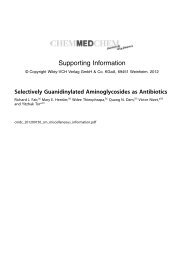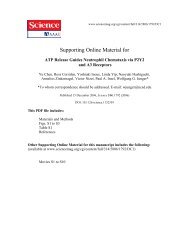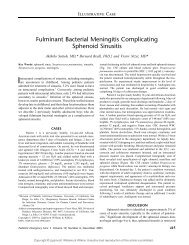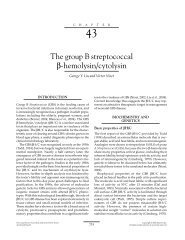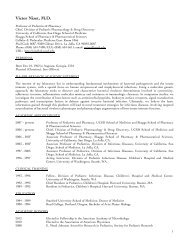BACTERIAL SEPSIS AND MENINGITIS - Nizet Laboratory at UCSD
BACTERIAL SEPSIS AND MENINGITIS - Nizet Laboratory at UCSD
BACTERIAL SEPSIS AND MENINGITIS - Nizet Laboratory at UCSD
You also want an ePaper? Increase the reach of your titles
YUMPU automatically turns print PDFs into web optimized ePapers that Google loves.
infant’s body fluids. If the infant is infected and the bacterial<br />
p<strong>at</strong>hogen is susceptible to the drug administered to<br />
the mother, cultures of the infant can be sterile despite a<br />
clinical course suggesting sepsis.<br />
TREATMENT OF AN INFANT WHOSE<br />
<strong>BACTERIAL</strong> CULTURE RESULTS ARE<br />
NEGATIVE<br />
Whether or not the mother received antibiotics before<br />
delivery, the physician must decide on the subsequent<br />
course of therapy for the infant who was tre<strong>at</strong>ed for presumed<br />
sepsis and whose bacterial culture results are neg<strong>at</strong>ive.<br />
If the neon<strong>at</strong>e seem to be well and there is reason<br />
to believe th<strong>at</strong> infection was unlikely, tre<strong>at</strong>ment can be<br />
discontinued <strong>at</strong> 48 hours. If the clinical condition of the<br />
infant remains uncertain and suspicion of an infectious<br />
process remains, therapy should be continued as outlined<br />
for documented bacterial sepsis unless another diagnosis<br />
becomes apparent. Significant bacterial infection can<br />
occur without bacteremia. Squire and colleagues [645]<br />
found th<strong>at</strong> results of premortem blood cultures were neg<strong>at</strong>ive<br />
in 7 (18%) of 39 infants with unequivocal infection<br />
<strong>at</strong> autopsy. Some infants with significant systemic bacterial<br />
infection may not be identified by the usual single<br />
blood culture technique. The physician must consider<br />
this limit<strong>at</strong>ion when determining length of empirical therapy.<br />
If tre<strong>at</strong>ment for infection is deemed necessary, parenteral<br />
administr<strong>at</strong>ion for 10 days is recommended.<br />
MANAGEMENT OF AN INFANT WITH<br />
CATHETER-ASSOCIATED INFECTION<br />
Investig<strong>at</strong>ors in Connecticut found th<strong>at</strong> multiple c<strong>at</strong>heters,<br />
low birth weight, low gest<strong>at</strong>ional age <strong>at</strong> birth, and low Apgar<br />
scores were significant risk factors for l<strong>at</strong>e-onset sepsis<br />
[504]. Benjamin and colleagues [505] reported a retrospective<br />
study <strong>at</strong> Duke University from 1995-1999 of all neon<strong>at</strong>es<br />
who had central venous access. The goal of the<br />
Duke study was to evalu<strong>at</strong>e the rel<strong>at</strong>ionship between central<br />
venous c<strong>at</strong>heter removal and outcome in bacteremic neon<strong>at</strong>es.<br />
Infants bacteremic with S. aureus or a gram-neg<strong>at</strong>ive<br />
rod who had their c<strong>at</strong>heter retained beyond 24 hours had<br />
a 10-fold higher r<strong>at</strong>e of infection-rel<strong>at</strong>ed complic<strong>at</strong>ions than<br />
infants in whom the central c<strong>at</strong>heter was removed promptly.<br />
Compared with neon<strong>at</strong>es who had three or fewer positive<br />
intravascular c<strong>at</strong>heter blood cultures for CoNS, neon<strong>at</strong>es<br />
who had four consecutive positive blood cultures were <strong>at</strong><br />
significantly increased risk for end-organ damage and de<strong>at</strong>h.<br />
In neon<strong>at</strong>es with infection associ<strong>at</strong>ed with a central venous<br />
c<strong>at</strong>heter, prompt removal of the device is advised, unless<br />
there is rapid clinical improvement and steriliz<strong>at</strong>ion of<br />
blood cultures after initi<strong>at</strong>ion of therapy.<br />
TREATMENT OF NEONATAL <strong>MENINGITIS</strong><br />
Because the p<strong>at</strong>hogens responsible for neon<strong>at</strong>al meningitis<br />
are largely the same as the p<strong>at</strong>hogens th<strong>at</strong> cause neon<strong>at</strong>al<br />
sepsis, initial therapy and subsequent therapy are<br />
similar. Meningitis caused by gram-neg<strong>at</strong>ive enteric<br />
bacilli can pose special management problems. Eradic<strong>at</strong>ion<br />
of the p<strong>at</strong>hogen often is delayed, and serious complic<strong>at</strong>ions<br />
can occur [23,119,348,632]. The persistence of<br />
CHAPTER 6 Bacterial Sepsis and Meningitis<br />
261<br />
gram-neg<strong>at</strong>ive bacilli in CSF despite bactericidal levels<br />
of the antimicrobial agent led to the evalu<strong>at</strong>ion of lumbar<br />
intr<strong>at</strong>hecal [646] and intraventricular [647] gentamicin.<br />
Mortality and morbidity were not significantly different<br />
in infants who received parenteral drug alone or parenteral<br />
plus intr<strong>at</strong>hecal therapy [646]. The study of intraventricular<br />
gentamicin was stopped early because of the<br />
high mortality in the parenteral plus intraventricular therapy<br />
group [647].<br />
Feigin and colleagues [629] reviewed the management<br />
of meningitis in children, including neon<strong>at</strong>es. Ampicillin<br />
and penicillin G, initially with an aminoglycoside, are<br />
appropri<strong>at</strong>e antimicrobial agents for tre<strong>at</strong>ing infection<br />
caused by GBS. Cefotaxime has superior in vitro and in<br />
vivo bactericidal activity against many microorganisms<br />
[621]. Tre<strong>at</strong>ment of enteric gram-neg<strong>at</strong>ive bacillary meningitis<br />
should include cefotaxime and an aminoglycoside<br />
until results of susceptibility testing are known.<br />
If meningitis develops in a low birth weight infant who<br />
has been in the nursery for a prolonged period or in a neon<strong>at</strong>e<br />
who has received previous courses of antimicrobial<br />
therapy for presumed sepsis, altern<strong>at</strong>ive empirical antibiotic<br />
regimens should be considered. Enterococci and antibiotic-resistant<br />
gram-neg<strong>at</strong>ive enteric bacilli are potential<br />
p<strong>at</strong>hogens in these settings. A combin<strong>at</strong>ion of vancomycin,<br />
an aminoglycoside, and cefotaxime may be appropri<strong>at</strong>e.<br />
Ceftazidime or meropenem in addition to an aminoglycoside<br />
should be considered for P. aeruginosa meningitis.<br />
Other antibiotics may be necessary to tre<strong>at</strong> highly<br />
resistant organisms. Meropenem [648], ciprofloxacin<br />
[649–651], or trimethoprim-sulfamethoxazole [652,653]<br />
can be the only antimicrobial agents active in vitro against<br />
bacteria th<strong>at</strong> are highly resistant to broad-spectrum<br />
b-lactam antibiotics or aminoglycosides. Some of these<br />
drugs require careful monitoring because of toxicity to<br />
the newborn (see Chapter 37), and ciprofloxacin has not<br />
been approved for use in the United St<strong>at</strong>es in infants<br />
younger than 3 months. Definitive tre<strong>at</strong>ment of meningitis<br />
caused by gram-neg<strong>at</strong>ive enteric bacilli should be<br />
determined by in vitro susceptibility tests; consult<strong>at</strong>ion<br />
with an infectious diseases specialist can be helpful.<br />
Use of dexamethasone as adjunctive tre<strong>at</strong>ment in childhood<br />
bacterial meningitis has been recommended based<br />
on reduction of neurologic sequelae in infants and children,<br />
in particular hearing loss and especially in cases of<br />
H. influenzae type b meningitis. Only one randomized<br />
controlled study exists for neon<strong>at</strong>es; in 52 full-term neon<strong>at</strong>es,<br />
mortality (22% dexamethasone versus 28% controls)<br />
and morbidity <strong>at</strong> 24 months (30% versus 39%)<br />
were not significantly different between groups [654].<br />
If cultures of blood and CSF for bacterial p<strong>at</strong>hogens<br />
by usual labor<strong>at</strong>ory techniques are neg<strong>at</strong>ive in the neon<strong>at</strong>e<br />
with meningitis, the differential diagnosis of aseptic meningitis<br />
must be reviewed, particularly in view of diagnosing<br />
tre<strong>at</strong>able infections (Table 6–18).<br />
MANAGEMENT OF AN INFANT WITH<br />
A BRAIN ABSCESS<br />
If purulent foci or abscesses are present, they should be<br />
drained. Some brain abscesses resolve with medical therapy<br />
alone, however [348,655]. Brain abscesses can be



